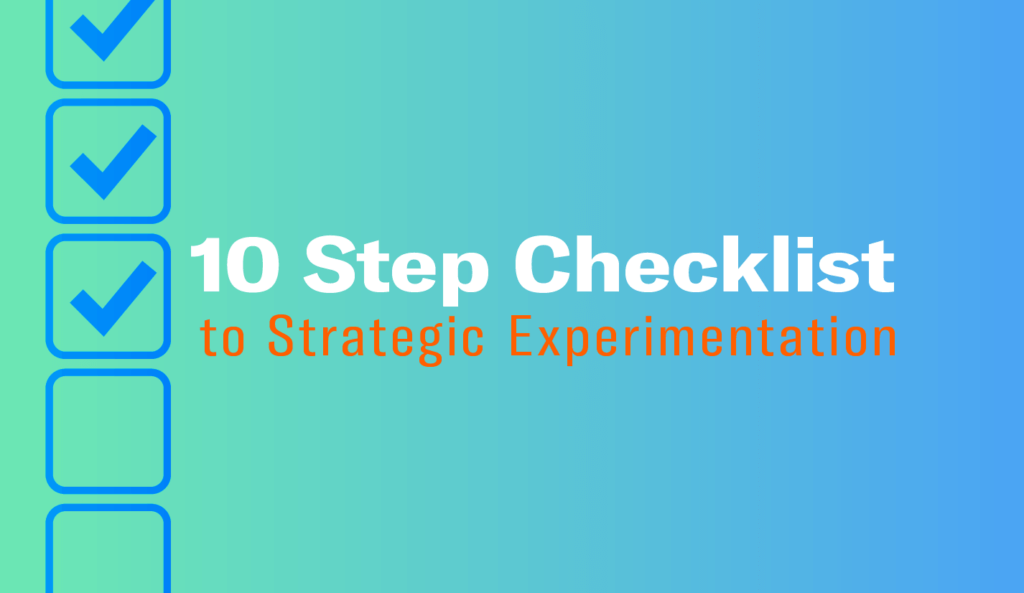10 Steps to Strategic Experimentation

Ozlem Senlik Staff Data Scientist, Airship

Share to my network
In this article
Categories
Book a meeting
Connect with our team of experts to discuss your conversion and loyalty goals, and how we can help you achieve them faster.
Get a demoMost businesses recognize the importance of experimentation, but many need to tap its full potential. Often, they run experiments in isolation, without coordination or a well-defined plan. Such experiments typically address only one aspect of the marketing strategy at a time. Although this approach may seem more straightforward, it comes with disadvantages of inefficiency, limited risk management, lack of comprehensive insights, and reduced responsiveness.
What Strategic Experimentation Looks Like
Strategic experiments, on the other hand, are multiple experiments conducted concurrently or sequentially. Each experiment is designed to address specific goals and key performance indicators (KPIs), while coordination across experiments unlocks comprehensive insights into various aspects of the marketing strategy and how different elements interact with each other to impact KPIs. A comprehensive, structured experimentation plan is essential to maximize the benefits of strategic experimentation.
The primary objective of strategic experimentation is to support overall marketing strategy by providing a holistic understanding of marketing assumptions, hypotheses and learnings gleaned from experimentation. Ideally, strategic experimentation should optimize not only the entire marketing funnel and lifecycle but the entire customer experience — with data-driven insights enabling faster, better decision-making across the business.
Why Experiment Strategically?
Compared to traditional isolated experiments, a strategic approach to experimentation offers several advantages:
- Efficiency: Coordinating experiments in a structured plan saves time and resources, enabling businesses to gather broader insights and make significant improvements across more areas more efficiently.
- Risk Mitigation: By considering potential risks and dependencies during planning, businesses can mitigate negative consequences that might affect multiple experiments.
- Deeper Insights: Running multiple experiments concurrently or sequentially allows a better understanding of how different variables interact with each other and impact overall marketing performance.
- Adaptability: Coordinated experimentation across communication channels, apps and websites enables businesses to respond quickly and consistently to emerging trends or market changes.
There are plenty of inspirational, value-laden stories of breakthrough tactics, strategies and even entire companies that were the direct by-product of experimentation.
Here’s Your 10-Step Checklist
Here’s a handy 10-step list to create and implement a strategic experimentation plan for your own business:
- Define Goals and Objectives: Start by clearly outlining your digital marketing goals and objectives. Determine what you want to achieve with your experiments. How do these line up with your near- and long-term marketing goals and objectives? Common goals include increasing website or app traffic, improving conversion rates, enhancing user engagement or boosting overall revenue.
- Identify Key Metrics: Identify the key performance indicators (KPIs) that align with your goals. These metrics will be essential in evaluating the success of each experiment. For example, if your goal is to increase conversion rates, your KPIs could be click-through rates, conversion rates and revenue per visitor.
- Brainstorm Experiment Ideas: Gather input from your marketing team and stakeholders to brainstorm potential experiment ideas. Consider various aspects of your digital marketing strategy, such as website/app design, landing pages, email campaigns, ad copy and visuals.
- Prioritize Based on Impact: Evaluate each experiment idea based on its potential impact on the identified KPIs. Rank them from high to low based on their estimated potential for significant improvements. Consider both short-term wins and long-term impact when prioritizing experiments.
- Consider Complexity and Resources: Assess the complexity of each experiment and the resources required for implementation. Some experiments may require significant design and development work, while others can be easily executed with existing tools. Prioritize experiments that are feasible to implement with your current resources.
- Analyze Risk and Dependencies: Identify any potential risks associated with each experiment. Consider dependencies between experiments and ensure that running one experiment will not negatively impact others or skew the results.
- Implement a Testing Framework: Establish a structured testing framework that includes timelines, test duration and sample size considerations. This framework should ensure that experiments are conducted consistently and results are statistically significant.
- Monitor and Analyze Results: Implement the experiments according to the plan and closely monitor the results. Gather data and analyze the performance against the predefined KPIs. Use statistical significance tools to ensure that the results are reliable and valid.
- Learn and Iterate: Based on the results, learn from each experiment’s outcome. Whether successful or not, use the insights gained to refine your marketing strategies and develop new experiment ideas. Continuously iterate and update your experimentation plan based on the learnings.
- Repeat the Process: Experimentation is an ongoing process. As you implement new ideas and strategies, reassess and reprioritize your experimentation plan regularly to stay responsive to market changes and optimize your digital marketing efforts.
Following this systematic approach, you can create an experimentation plan that helps you prioritize and execute a series of experiments to drive continuous improvement in your digital marketing performance.
BONUS! Learn from even more brand experts in the on-demand Airship webinar, Unlock the Power of Continuous Experimentation, where Sienne Veit and Tom Burrell explore how leading companies use continuous experimentation to intelligently optimize mobile experiences, boost app retention and grow revenue.